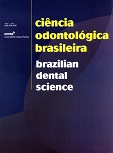Relation Between the Craniocervical Cephalometric Analysis and Class I, II and III Skeletic Patterns in Young Subjects
DOI:
https://doi.org/10.14295/bds.2012.v15i1.739Palavras-chave:
Radiologia Odontológica, OrtopediaResumo
The skull posture on the spine is an important factor for the diagnosis of craniomandibulars functional disorders in children, as well as in adults. Alterations in biomechanics may be evidenced in common x-rays. The aim of this study was to relate findings of craniocervical analysis with skeletal pattern Class I, II, III in individuals from 7 to 12 years old. X-rays of 92 individuals were taken by NHP method and digitalized for computerized analysis of skeletic patterns and craniocervical analysis. Descriptive analysis was used to relate craniocervical analysis values with the type of skeletal pattern presented by individuals. For skeletal pattern Class I, II and III, nasopharyngeal soft tissue percentage and oropharyngeal soft tissue linear quantity were above normality value; nasopharyngeal cervical plot was normal and hyoid triangle was positive for the majority of the individuals. The angular relationship between skull and cervical spine show values lower than those considered normal for skeletal pattern class I and II. It was concluded that in the majority of the individuals with skeletal pattern Class I, II and III had high values of airway blockage, head posterior rotation, nasopharyngeal cervical plot with normal values and positive hyoid triangle.
Downloads
Downloads
Arquivos adicionais
Publicado
Como Citar
Edição
Seção
Licença
TRANSFERÊNCIA DE DIREITOS AUTORAIS E DECLARAÇÃO DE RESPONSABILIDADE
Toda a propriedade de direitos autorais do artigo "____________________________________________________________________" é transferido do autor(es) para a CIÊNCIA ODONTOLÓGICA BRASILEIRA, no caso do trabalho ser publicado. O artigo não foi publicado em outro lugar e não foi submetido simultaneamente para publicação em outra revista.
Vimos por meio deste, atestar que trabalho é original e não apresenta dados manipulados, fraude ou plágio. Fizemos contribuição científica significativa para o estudo e estamos cientes dos dados apresentados e de acordo com a versão final do artigo. Assumimos total responsabilidade pelos aspectos éticos do estudo.
Este texto deve ser impresso e assinado por todos os autores. A versão digitalizada deverá ser apresentada como arquivo suplementar durante o processo de submissão.




























